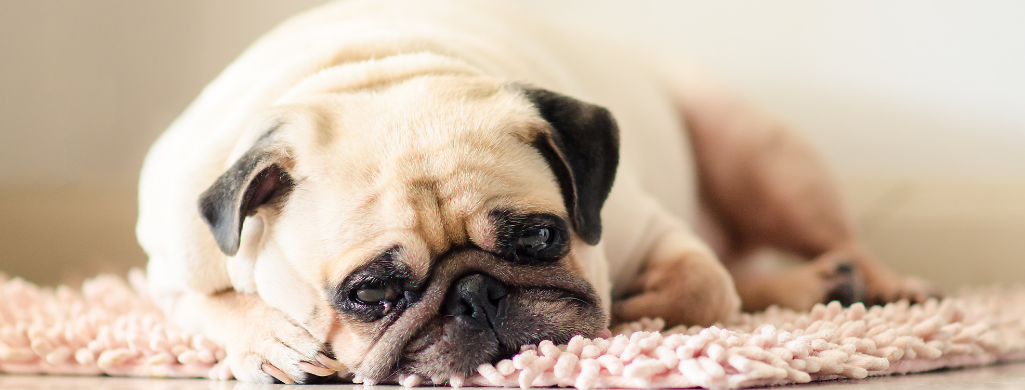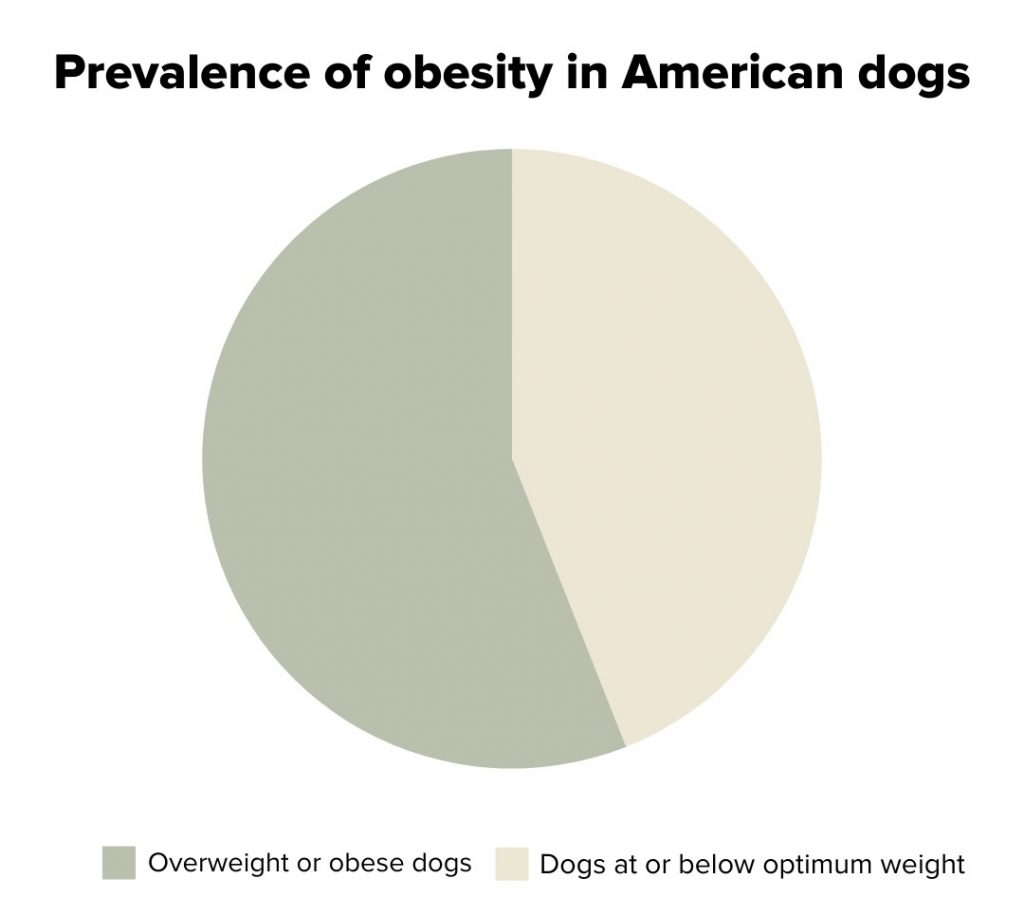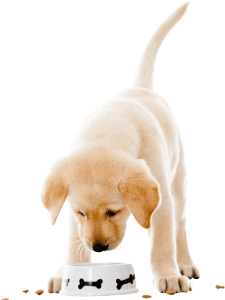
Here are my top 12 weight loss tips to help your dog lose weight.
As a vet, I know first hand that obesity in dogs is becoming a real problem.
The Association of Pet Obesity Prevention estimates that 55.8% of American dogs are either overweight or obese.
A study in the UK found out that 65% of the adult dogs examined in 5 localities were overweight and 9% were obese.
These are alarming numbers given that obesity comes along with a host of health issues that can be very bad for your dog.
Nowadays, veterinarians feel that educating people about excessive weight gain and weight loss for dogs is one of the best ways to ensure that Fluffy is going to have a long healthy life. [1, 2]

Ok, my dog is plump but why should it matter?
Like in humans, excessive weight can increase the risk of certain health problems in dogs. Some of these issues are: [2]
- Decreased cardiovascular health
- Diabetes
- Arthritis
- Hip dysplasia
- Exercise intolerance
- Cancer
- Urinary bladder stones
Dogs that tend to be leaner throughout their life tend to live longer and maintain their lean body weight to fat ratio for longer than dogs that were overweight.
These dogs also tend to maintain their bone mineral density better than dogs carrying a lot of weight. [3]
Maintaining your dog’s weight can also be useful to notice any abnormalities quickly. An example of this is Cushing’s disease, which causes dogs to develop a potbelly.
If your dog is already quite chubby it is harder to notice and you might be tempted to dismiss it as your dog getting older or chubbier.
If you are careful with your dog’s weight and a potbelly appears without explanation you might spot this quickly and start treating this disease quickly.
But what can I do to help my dog lose weight?
If your dog is one of the many dogs shaped like a Bologna sausage, we’ve got news … your dog needs to lose weight!
Weight loss can be quite challenging for dogs, especially since they depend on us to help them manage it.
If it was up to them, many dogs would gorge themselves with food like there was no tomorrow.
Follow these tips to help your dog manage their weight better or lose a few pounds to get to their ideal weight.
1. Change the way you think about food
Obesity in humans around the world has reached epidemic proportions. The reasons for this are varied and complex but unfortunately as our canine companions are becoming more important in our day to day life they are following us on the same trajectory.
The lives of owners and their dogs are so intertwined that in the case of this problem an owner’s relationship with food will often determine the kind of attitude the owner takes to feeding their dog.
Improving your relationship with food will make you acutely aware of what and how much you are feeding your dog and this can only be of benefit to both of you.
Taking on this journey with your dog can be a good way to hold yourself accountable and form healthy habits.
2.. Stick to the food bag’s feeding guide
It is often tempting to feed your dog more than the measly portion that your dog food bag tells you to.
How could they ever get by with that? These are the kinds of thoughts that allow us to justify overfeeding our dogs.
The most accurate way to know what portion size to feed your dog is to invest in a kitchen scale. For small dogs especially, just a few extra grams every day can really add up over time!
Another important part is to know your dog’s weight accurately so that you can follow the food’s instructions correctly.
This is easily done (well, unless your dog is a 150lb Great Dane!) by weighing yourself while holding your dog and subtracting your own weight.
Keep in mind that most portions stated on food bags are the recommended amounts per day, not per portion- so if your dog eats three times a day, remember to divide the number by three for each meal.
When in doubt, the bag will specify whether it is per portion or per day.
While different dogs have different metabolic needs, one should approach tinkering with your dog’s suggested portion with caution. When not following a good guide, it is always suggested to monitor your dog’s body condition score regularly.
It would also be wise to ask your vet’s opinion as tweaking your dog’s diet might cause some nutrient imbalances with time and it might be that your dog would be better off on a different complete, balanced diet.
3. Encourage your dog to drink at feeding time
Encouraging your dog to drink at feeding time will make them feel fuller and less likely to beg afterward.
When doing this it is important to make sure that your dog is not eating excessively as the water might make the food expand in your dog’s stomach and cause your dog discomfort or even bloat.
If your dog doesn’t like to drink at feeding time, add some water to the food or replace some of the dry kibbles with wet food.
If you are going to top your dog’s dry food with wet food, it is best to choose a diet that gives instructions on how to mix the two and keep a balanced diet.
The higher water content in such a diet will help your dog feel full quicker and will help him to feel satisfied with less.
For the more finicky pups out there, you can make the water a little more appealing by adding a tiny amount of something tasty, like meat stock.
4. Give your dog low-calorie nutritious treats
Most dog biscuit treats that you find on the market contain many calories. This is obviously not very good for dogs struggling to lose weight if given regularly.
It is better to find chew sticks that are made from meat but some vegetable treats that you might have in the pantry or refrigerator could be good alternatives.
A good alternative is carrots. Carrots are high in fiber, taste good, and are not full of refined sugar. They are also good for your dog’s teeth.
Other alternatives are:
- Apple (without a core)
- Cucumber
- Frozen peas
- Melon
- Strawberries
These alternatives will help you keep your dog happy while keeping your dog at a healthy weight.
However, as with everything, moderation is key. Too much of a good thing can still have a bad effect on your dog.
If using a high volume of treats or high-calorie treats, e.g. for training purposes, remember to reduce the amount of your dog’s main meals accordingly to account for the extra calories.
5. High protein, low carbohydrate diets
These kinds of diets have been found to stimulate weight loss in dogs. This is achieved by causing a calorie deficit while keeping protein levels high.
Weight loss using more conventional methods usually leads to lean muscle mass loss along with the loss of body fat.
These high protein diets are more effective at maintaining your dog’s lean muscle mass during this weight loss process. [4]
Consult a vet before using such a diet if your dog suffers from liver and kidney issues.
The high protein levels in these diets might strain your dog’s liver and kidneys and cause more harm to your dog.
6. High protein, high fiber diet
This diet uses a similar principle to the high protein, low carbohydrate diet above but relies on the satiety inducing effect of protein and more importantly dietary fiber to make your dog feel full quicker.
This kind of diet will also prevent your dog from feeling hungry for a longer period without taxing the dog’s liver and kidneys with huge amounts of protein.
The high protein and high fiber aspect of these diets are shown to be able to promote weight loss while having the same amount of calories as other less effective products.
It is also thought that the high protein and high fiber diet will help better with losing weight, than a high protein or high fiber only diet. [5]
7. Physical activity
This shouldn’t come as a surprise, but physical activity helps your dog stay at a healthy weight. This is through the expenditure of energy.
Moderate amounts of physical activity are also good to support cardiovascular health and the musculoskeletal system.
Take the excuse to exercise with your dog and to find new ways to make exercise more fun.
This way your dog can be your exercise buddy and you can hold each other accountable for those times when either one of you feels like lazing about rather than exercising.
It doesn’t just have to mean long walks, or going for a run- think outside the box!
Playtime, for example fetching a ball or trying some agility obstacles, can be a great way to get the exercise in, and enjoy yourselves at the same time.
8. Feed at specific times
Feeding your dog at specific times during the day can also help your dog lose weight by creating a routine.
Having clear “meal times” during the day will allow your dog to behaviourally adapt their appetite.
This can also result in less begging and therefore fewer occasions during the day where your dog can tempt you to feed them excessively.
9. Feed multiple times a day
If your dog is having trouble not feeling hungry at certain times of the day, try dividing their daily food portion into more meals.
This way you will be feeding your dog the same amount of food while allowing them frequent times of respite in this dietary relay race.
This is especially useful with large dogs. Large dogs have large hefty portions and these can be somewhat problematic.
If a large dog is fed one large portion a day this can cause abdominal discomfort and sometimes bloat. Bloat can lead to emergencies like Gastric Dilatation and Volvulus.
10. Do not leave the food out when feeding time is over
It is not ideal to leave your dog’s food out to eat at their leisure. Even more, if you are one of those owners that never allows your dog’s food bowl to be empty.
This is one of those feeding methods commonly associated with excessive weight gain. When using this method, it is very easy to lose track of how much your dog is eating. We, therefore, suggest taking the food away after feeding time.
11. Help your dog eat slower
Eating slower and more mindfully allows your body to actually realize how much food it is ingesting. The same applies to dogs.
As you might have realized from how fast any food item vanishes after it hits the floor, dogs are opportunistic eaters.
They eat first and ask questions later and this also happens when it comes to their own food. There are a number of ways to slow down your dog while eating.
One such method is by turning mealtime into a game. This can be done by putting the dog’s meal into a toy designed for food games.
Besides slowing your dog’s eating down this also stimulates your dog’s brain.
Another simple way is to spread your dog’s food onto the ground. This costs nothing and is an effective way to get your dog to slow down and to look for its food.
Avoid spreading dog food on floors that might have stones or other small objects as these can be mistaken for food by your dog and can be swallowed.
Another way is to use a slow feeding bowl. These bowls come in all shapes and sizes and are designed to make your dog’s food challenging to eat.
12. Monitor your dog’s body condition & Body condition scoring
Simply weighing your dog regularly won’t be a sufficient indicator of fat loss. This is because muscle weighs more than fat, so with a proper diet and exercise, the healthy changes in your dog’s body might not show up on the scale.
A very important part of any dog weight loss program is to monitor your dog’s body condition. It is simply not enough to just feed a low-calorie diet or do any of the above tips if you are not willing to keep an eye on your dog’s body condition.
There are a number of body condition scoring charts like this one. This is because different dogs react differently to different diets and weight management methods due to their own individual physiology and sometimes due to underlying health conditions that you might not be aware of.
The bottom line
We hate to be the party poopers, but if you are one of those owners that fall for their dog’s puppy eyes when food is around, or you’re one to oblige to your dog’s requests for more food after hoping they would stick to the suggested amounts, you are unfortunately killing your dog with kindness.
As an owner, you have the responsibility to manage your dog’s health, and sometimes you need to be strict with both your dog and yourself if you are to do this right.
It is important that your dog does not shed weight too quickly as this can harm your dog. We hope that the above tips will help you maintain your dog’s healthy weight or put you on the right path to get your dog’s weight under control.
We suggest that you speak with your veterinarian if you need help deciding if your dog is overweight, or if you are finding difficulty managing your dog’s weight.

